This is a tough post to read, tougher to look at. Some background might help. In 1993 Chris Arnade got a PhD in physics and then went to work on Wall Street. Starting in 2007, Chris started taking long walks with his camera through New York City, where he found a lot of ambiguity and unsolvable problems. By 2010 he was spending all of his spare time in the Hunts Point neighorhood of the Bronx, documenting the stories of street addicts. In 2012 he quit his job to dedicate his full time to the project. His collaborator in the project is Cassie Rodenberg, who writes the Scientific American blog, The White Noise.— LWON eds
My first career was studying the rules that drive the material world, theoretical physics. Physicists use extremes to learn how nature works: They take stuff and smash it together at really high speeds to strip matter of the ancillary fluff and expose the essential core.
My current career, of working with homeless addicts in the Hunts Point neighborhood of the Bronx, is equally revealing. It is seeing life stripped of ancillary fluff, leaving what is essential. It exposes the things often forgotten when you have a steady job, a supportive family, and own lots and lots of stuff.
Gone are the material and social pleasantries that mask our perceptions of being human. A street addict’s life is about hustling for the next meal, the next place to sleep, the next fix. About staying alive.
For physicists the essential core is composed of a handful of particles, of which the most essential of the essential are six quarks. Six particles that combine and interact to make up everything. Six varieties of Lego pieces.
In Hunts Point three rules dominate: The three quarks of life.
1. Everyone will die. So much of what we do is about the fear of death or denial of death. We structure our physical lives around delaying death, eating what we are told, exercising how we are told, or feeling guilty if we don’t. We focus our spiritual lives grappling with mortality or anesthetizing ourselves to the consequences of mortality.
Most people, thankfully, don’t see death regularly. Street addicts know death well. It’s tauntingly close, just a really good bag of shit or a really bad John away.
They are far less concerned with nutritional fads, the latest exercise fad. Those are absurd luxuries far out of reach, “You want to live eighty boring years running on a fucking treadmill and eating grass and seeds like a rat?”
Spiritualism dominates. Hope and comfort is found in a mix of the Bible, superstition, and folklore. Nobody believes the physical world is all there is. Shelly, 38, has been prostituting since she was 13, “This is only one part of our journey. It’s a really shitty part we got to endure, but each life gets better and better, until you happy and content, not running around trying to keep from being locked up, beat up, or kicked down.”
2. The world is run by and for men, mostly white men, but really all men. They make the rules, mostly to benefit themselves, and everyone else is left to deal with that. On the streets this is a visceral reality, a “if you happen to forget it, the truth will be beat into you.”
There are no women driving around Hunts Point looking to pay for sex. There are no women raping boys put in their care. There are very few women physically abusing their partners.
There are women doing hard, demeaning, and dangerous work. They prostitute themselves to men. The money they make goes to buying drugs not only for themselves, but also for boyfriends or husbands.
Those boyfriends or husbands are pimps, but that words isn’t used much. Pimps are supposed to provide something, perhaps protection, perhaps contacts. On the streets these men provide none of that, they provide no economic value.
They don’t work, they don’t protect, they sit around using the drugs bought with the money the women make. They do have one part of being a pimp down: They beat the women.
Almost everyone, women and men, addicted to drugs and without a home, fled an abusive childhood, one where a father, uncle, or mother’s boyfriend, beat or sexually abused them.
The entire cycle of a female street addict’s life is of abuse, of being used and demeaned by men.
3. Everyone is alone, and nobody wants to be. Loneliness haunts street addicts constantly. They have been alone almost all their lives, few having known someone they can trust. Raped by their fathers or brothers, put into foster homes and sometimes guided into prostitution by relatives, they have often run away before they are adults.
Despite trusting almost nobody almost everyone is in a relationship. Street families are formed, with older women acting as mothers to younger women, older man as fathers to the boys.
Women get little in perceived value back from their partners, yet almost every woman has a boyfriend, or a husband, or a girlfriend.
The women want someone who can soften the pangs of loneliness: Someone to believe and understand them, someone to bring them that little extra to their life. To find that they are forced to play long odds, to hope that the next man isn’t into beatings, because the even odds are not available. Rationality, economic decisions, are trumped by the emotional.
Vanessa, 38, has lived on the streets almost all her life. If alone and searching for a place to sleep, she loudly talks to herself. “It makes me feel less alone, makes the guys out there think twice before jumping me. Maybe I was with someone. I ain’t but it makes them think I am, and sometimes I even think I am.”
A goal of physics is to find an equation that combines all the rules. That unifies all we know about something.
Egypt has lived on the streets since 14. She named herself after a place she dreams of visiting, but knows she never will. She was taking protection against the rain under a shop awning, her eye blackened by her boyfriend, her body bruised by him. She was recounting every man who has raped her, who has beaten her, who has abused her.
I asked, “Has any man in your life ever treated you well?”
“Yes, one has. God.”
__________
Chris Arnade‘s Faces of Addiction” series explores addiction in the south Bronx. Follow him on Twitter: @Chris_arnade
__________
all photos by Chris Arnade
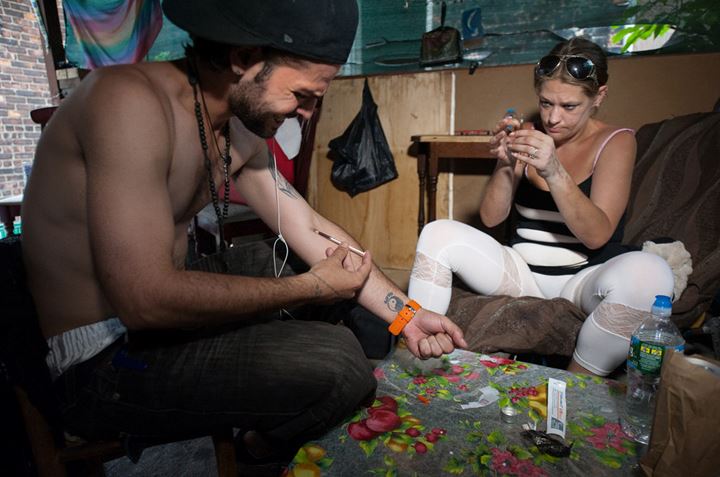
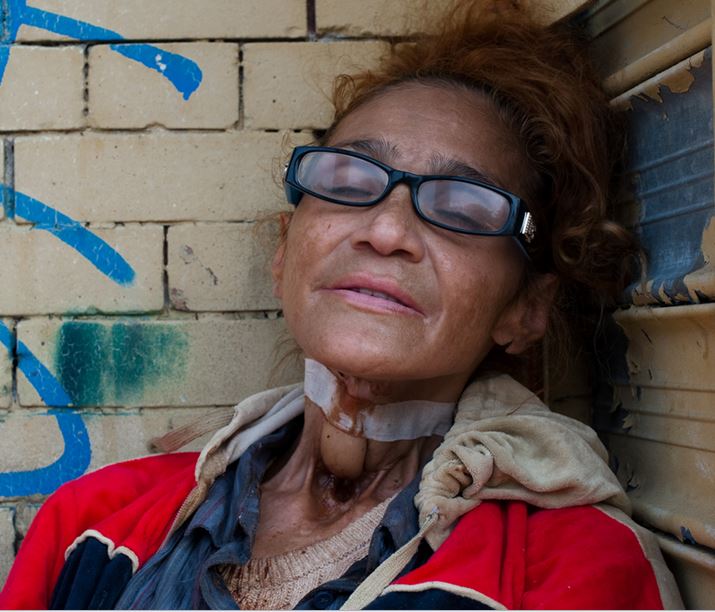
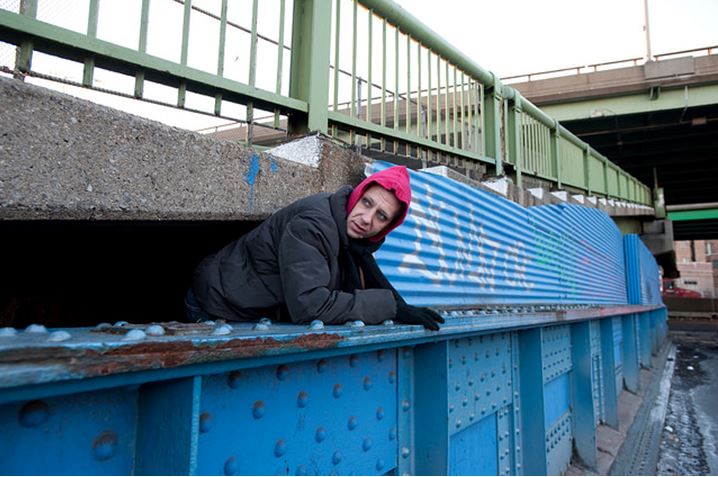
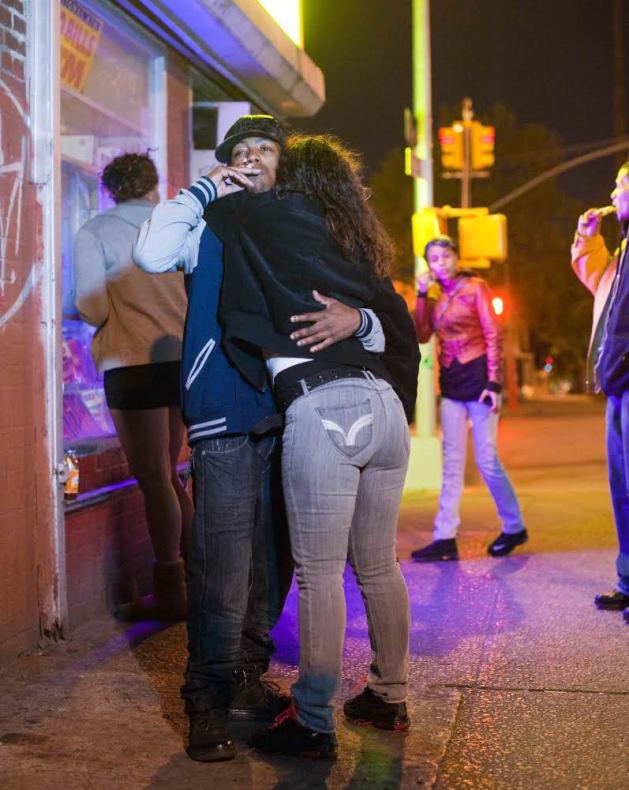
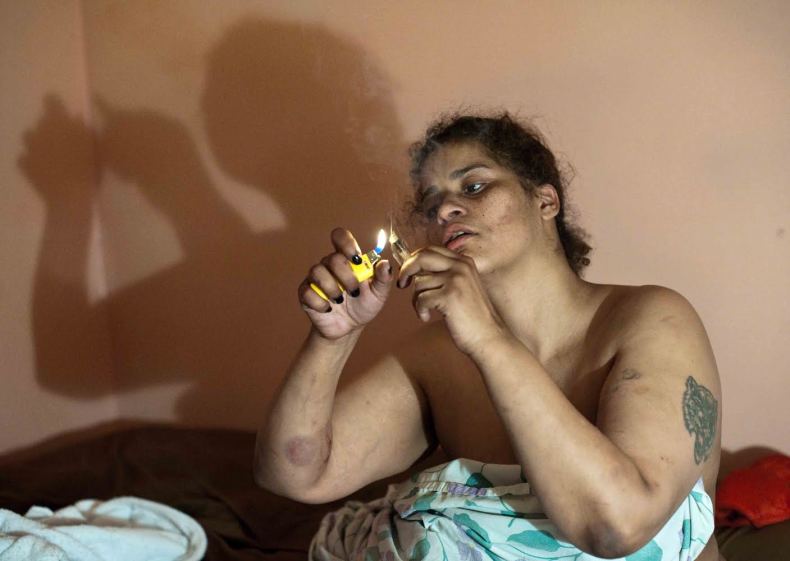
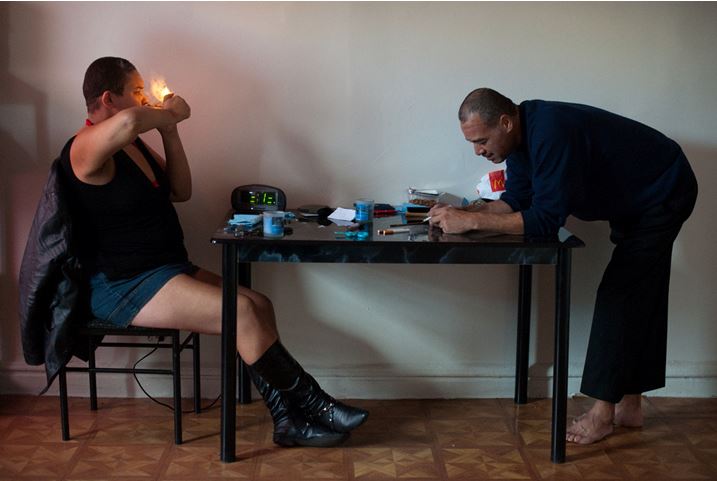
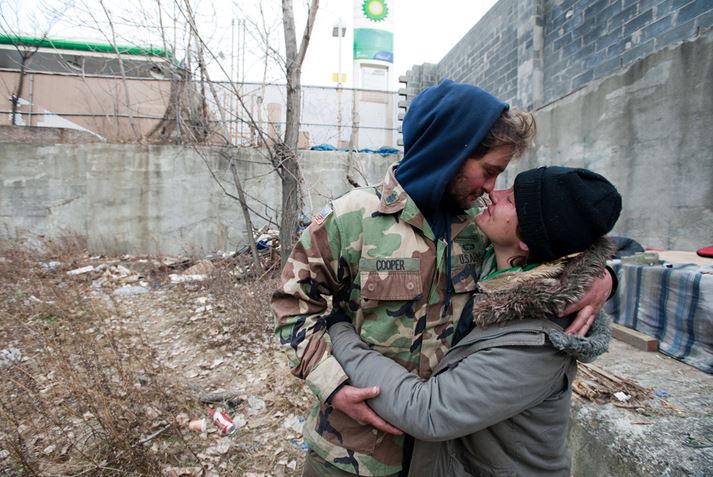
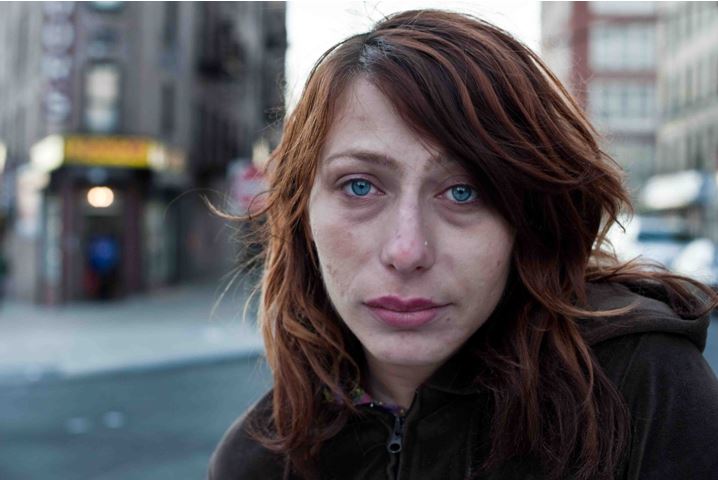

amen.
The Hunts Point stories show me places that I have never been or imagined. I worry about these people and wish that I could change their world. I pray for them . I understand why they turn to something to make them forget their pasts and their tommorrows.
Thank you for being there and reporting the stories . I know how blessed that I am .
Important look into a world that most of us never see. I hope this is a book project–and that many forthcoming articles place this issue before the public again. Great work, Chris! I have ideas for possible funding, etc. if you’d like to contact me.
Chris youre work is so horrible yet so beautiful.Horrible in the fact that these people are addicts…homeless…prostitutes.Yet beautiful as you are bringing theyre troubles to the fore for everyone to see and possibly able to get help for these poor soles.My daughter is/was a heroin addict and i have seen how that drug destroys lifes both for the addict and their families,my daughter has been so lucky as she has had the love and support from her family.This christmas i will not be eating a wonderful meal on christmas day,i will be going to help the salvation army in london to help them feed the homeless.
There but for the grace of chance….
It’s great photography and writing
Just sad that all men are made to look like demons and women the Angels
I only hope thatvMen like Chris will hopefully tour the family court system, the divorce and child custody industry to see how regular males are raped in daylight by alimony and child custody
But hey men’s trears aren’t glamourous ….. Are they ?
vinayak
These images, and the accompanying prose, are heart-breaking and haunting. Chris and Cassie, I deeply admire what you are doing. You are messengers from another world, the seventh circle of hell, and you remind those of us who live comfortable lives that we can never afford to be complacent. I sincerely hope that Vanessa, Egypt and the others in your photos find a way out of their pain, with the help and support of compassionate others. I also hope that their trust in both of you will be a first step.
This story… elicits many emotions… is something sooo unfamiliar to most readers that it feels like fable… however, in the context of human history it almost seems banal–like it has been imprinted somewhere within everyone and is therefore predictable… these people are not actually that different from anyone else, but their lives are by way of either chaos or truly divine force.
If u ever get away like I was able to… never forget where u come from. This journey made you who you are a survivor! A skill so few truly have! With love
Chris may i ask what has happened to aidas neck plz…also i wondered if ever you get frightened by taking the pics…as in do you get threatened at all by the pimps ?Also how is aida doing…her photo bothered me as if you look hard you see a beautiful kind woman.
@Debbie. Here is what I wrote on Aida after I took that picture
“Aida was once very beautiful. All those on the streets say it. “If you don’t look at the hole in her neck, at the tube coming out of her stomach, and look at her eyes, you can still see the beauty.”
“She used to walk down the street with her sweet four year old, holding hands. Then she started using and she lost everything.”
Aida couldn’t talk, but gestured for money.
Her hospital band, still on her wrist, gave details. Admitted to a nursing home weeks ago, born forty years ago.
“She does this all the time. She leaves a hospital, does drugs for two or three days, then collapses and we call the ambulance. Don’t bother calling now, she won’t go.”
I hugged Aida. Her fragile body was wet in my hands. The smell from her, of rotting flesh, overpowered me.
I went behind my car and vomited. Then I cried.”
her rotting flesh, chris? how was it “rotting”?
I asked, “Has any man in your life ever treated you well?”
“Yes, one has. God.” <- i'm pretty much an atheist but this makes a strong case for "god" to me. thanks chris
Chris when i looked at the wound i thought it was rotting…how very very sad…i can see the beauty in her lovely face….where is her child now….omg i just want to cry…life can be so cruel..addiction is so cruel and society is so cruel towards these people….chris you are an angel you truly are xx
One way that we might break this cycle is to stop paying poor, unmarried women to have children … children who are at heightened risk to drop out of school, to have mental health problems, to go to prison, and, yes, to become addicts. It is very hard to fix broken lives. An ounce of prevention is worth a pound of cure!